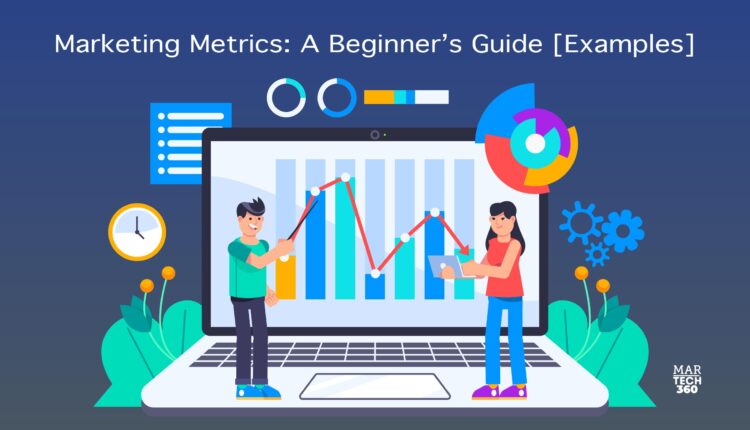Whether you’re starting fresh or want to improve your current marketing efforts, understanding the right marketing metrics is key to success. After all, how can you know if your strategy is working without clear goals? Effective marketing requires tracking numbers and analyzing data—it’s more science than guesswork.
Many businesses focus on basic metrics like website traffic, but that’s just scratching the surface. By digging deeper into advanced metrics, you can uncover valuable insights and find ways to make your marketing efforts even better.
Let’s jump in and learn everything about it.
What are Marketing Metrics?
Marketing metrics are quantifiable values that marketing teams aim to achieve within a certain timeframe. These metrics, also known as Key Performance Indicators (KPIs), can influence overall business success, such as boosting revenue, or specifically impact marketing department goals, like increasing form completions on a landing page by 50%.
Think of KPIs as the goalposts and marketing activities as the players scoring the goals. For instance, if a marketing team sets a KPI to increase web traffic by 50% within a set timeframe, they’ll then outline the specific goals and activities necessary to reach that KPI.
Examples of Marketing Metrics
 Marketing criteria play a crucial role in assessing the effectiveness of your campaigns. Across various marketing channels, different metrics provide insights into different aspects of performance.
Marketing criteria play a crucial role in assessing the effectiveness of your campaigns. Across various marketing channels, different metrics provide insights into different aspects of performance.
In email marketing, metrics like email opens, forwards, and unsubscribes offer valuable engagement indicators. Digital marketing efforts can be measured through metrics such as click-through rate, cost-per-action (CPA), and impressions.
On social media platforms, metrics like follower count, impressions/reach, and engagement rate help gauge audience interaction. Website performance can be monitored using metrics like total traffic, bounce rate, and conversions. Content marketing criteria can be measured through blog traffic, content shares, and qualified leads generated. Video and streaming TV ad performance can be assessed through metrics like impressions and total viewing time. Sales metrics include sales team response time, call volume, and reviews.
Revenue generated by each channel is a critical metric to track overall financial performance. SEO efforts can be evaluated through metrics like keyword rankings, search volume, and organic traffic. Finally, quality metrics like Quality Score, Net Promoter Score, reviews, and monthly recurring revenue provide insights into customer satisfaction and retention. By analyzing these metrics, marketers can make informed decisions and optimize their strategies for maximum impact.
Also Read: Lifecycle Marketing: A Beginner’s Guide [Best Practices]
Why Do Firms Use Metrics In The Marketing Plan?
 Firms incorporate metrics into their marketing plans for various reasons. Firstly, metrics offer a quantifiable means to monitor performance, evaluate campaign effectiveness, and assess their influence on business objectives. By leveraging marketing criteria, firms can refine existing campaigns, strategize for future initiatives, and make data-driven decisions. Moreover, metrics aid in pinpointing channels that yield the highest return on investment (ROI), empowering firms to allocate resources efficiently and enhance overall marketing strategies.
Firms incorporate metrics into their marketing plans for various reasons. Firstly, metrics offer a quantifiable means to monitor performance, evaluate campaign effectiveness, and assess their influence on business objectives. By leveraging marketing criteria, firms can refine existing campaigns, strategize for future initiatives, and make data-driven decisions. Moreover, metrics aid in pinpointing channels that yield the highest return on investment (ROI), empowering firms to allocate resources efficiently and enhance overall marketing strategies.
Why Does Marketing Metrics Matter?
Marketing criteria play a crucial role in measuring the success of marketing campaigns and informing strategic decision-making. According to a Google study conducted in collaboration with MIT, 89% of top marketers utilize strategic metrics such as gross revenue, market share, or customer lifetime value (CLV) to gauge campaign effectiveness. The benefits of leveraging these metrics and others include:
- Supporting Informed Decision-Making: By analyzing metrics, marketers gain valuable insights that enable them to make informed decisions regarding campaign strategies and optimizations.
- Identifying High ROI Channels: Metrics help identify which marketing channels yield the highest return on investment (ROI), allowing marketers to allocate resources effectively and optimize their budget allocation.
- Justifying Marketing Spend: Metrics provide tangible evidence of campaign performance, enabling marketers to justify marketing spend and secure budget allocations for future initiatives.
- Improving Overall Results: Tracking metrics allows marketers to identify areas of improvement and refine their strategies to achieve better results across various aspects of their campaigns.
- Maximizing Lead Conversions: Metrics enable marketers to pinpoint the most effective channels and methods for lead generation, helping them focus their efforts on maximizing lead conversions and driving business growth.
3 Important Marketing Metrics for Digital Platforms
When it comes to digital advertising, certain marketing criteria and key performance indicators (KPIs) take precedence in evaluating campaign success. While numerous metrics are monitored, each campaign typically focuses on a select few KPIs that are specific, measurable, and attainable within the campaign’s timeframe.
- Lead generation and conversion rate are paramount for measuring the effectiveness of digital advertising campaigns. Tracking new leads generated and the percentage of leads converted into customers provides valuable insights into campaign performance. For instance, Amazon Ads users can access conversion metrics like detail page views and purchases through campaign reporting and tools like Amazon Attribution.
- Return on investment (ROI) is another critical metric for digital marketers. Comparing customer lifetime value (CLV) to customer acquisition cost (CAC) helps gauge the effectiveness of marketing efforts. If CAC outweighs CLV, it may signal the need to adjust audience targeting strategies to improve ROI.
- Impression share is also vital in assessing digital advertising performance. It measures a brand’s visibility on a particular channel relative to its potential audience. A higher impression share suggests increased brand visibility, potentially leading to higher sales.
These three KPIs and metrics—lead generation, ROI, and impression share—serve as key indicators of digital advertising success and inform strategic decision-making for optimizing campaigns.
How Can You Setup a Marketing Metrics?
Setting key marketing metrics is essential for measuring the success of your marketing efforts. To ensure you choose the right metrics for your business, industry, preferred channels, and campaign types, follow these two straightforward steps:
- Identify Your Goals: Begin by clearly defining your marketing objectives. Whether your goal is to generate more leads, increase customer lifetime value (CLV), or achieve other specific outcomes, your chosen metrics should directly align with these goals.
- Stay Focused: While it’s tempting to track every possible metric, it’s important to stay focused on the ones that matter most for measuring success against your goals. Select metrics that provide meaningful insights into your marketing performance and align with your desired outcomes.
Winding Up
Marketing metrics serve as invaluable tools for firms, offering actionable insights into campaign performance, customer behavior, and overall return on investment. By leveraging these metrics, businesses can optimize their marketing strategies, allocate resources effectively, and make data-driven decisions that lead to improved performance and sustained growth in the competitive market landscape.


Comments are closed.